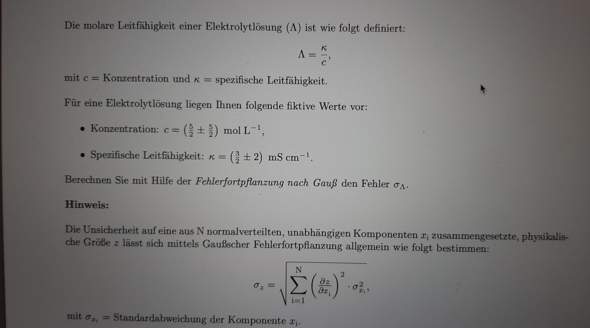Fehlerfortpflanzung nach Gauß der molaren Leitfähigkeit einer Elektrolytlösung?
Hey, ich brauche dringend Hilfe bei der folgenden Fragestellung. Ich freue mich über jede hilfreiche Antwort!

1 Antwort
Die Funktion lautet Λ(κ, c) = κ / c. Die Standardabweichungen von κ und c sind gegeben. Bestimme die partiellen Ableitungen ∂Λ / ∂κ und ∂Λ / ∂c, ermittle das totale Differential dΛ(κ, c) = (∂Λ / ∂κ) * dκ + (∂Λ / ∂c) * dc und wende darauf die Fehlerfortpflanzung - wie angegeben - an: σ_Λ² = (∂Λ / ∂κ)² * σ_κ² + (∂Λ / ∂c)² * σ_c².
Totales Differential:
σΛ = (∂Λ / ∂κ) * dκ + (∂Λ / ∂c) * dc
Fehlerfortpflanzung:
σΛ² = (∂Λ / ∂κ)² * σκ² + (∂Λ / ∂c)² * σc²
σΛ² = (1 / c)² * σκ² + (- κ / c²)² * σc²
σΛ² = (1 / (2,5 mol / L))² * (2 mS / cm)² + ((- 1,5 mS / cm) / (2,5 mol / L)²)² * (2,5 mol / L)²
σΛ² = (0,64 L² * mS² / mol² * cm²) + (0,36 L² mS² / (mol² * cm²))
σΛ = 1 L * mS / (mol * cm) = 1 * 1000 cm³ * 0,001 S / (mol * cm) = 1 S * cm² / mol
Was wäre denn das Ergebnis, damit ich die Rechnung überprüfen kann, da der Rechenweg entscheidend ist.